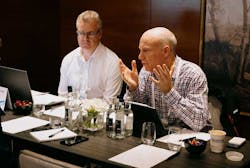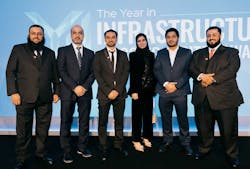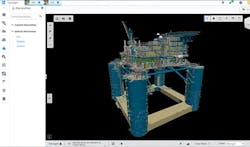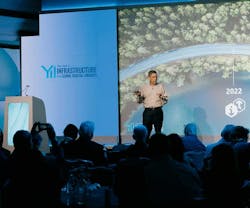Digital Twins: Designing Virtual Replicas of Infrastructure Projects
At a Glance:
- Bentley Systems hosted the 2022 Year in Infrastructure and Going Digital Awards in London (Nov. 14-15, 2022). The most advanced projects were those leveraging data to build better infrastructure.
- The extent to which Bentley Systems and its customers favor digital twin adoption for reengineering entire processes and experiences is a case study in optimizing performance.
- The annual event unveiled new digital twin technologies that help infrastructure companies synchronize and federate data of physical assets across complex user workflows.
Call it a superpower, but one of the greatest advantages of a digital twin is the ability to transform data into transformative information that map out future outcomes.
Keep in mind that the goal of using of digital twins differs with each application. The digital twins of every Tesla ever sold and the digital twin of professional NBA basketball player Carmelo Anthony, called “Digital Melo,” are ground-breaking (yet vastly different) examples.
For testing autonomous driving capabilities, for example, the goal might be to focus on innovation, efficiency and rapid iteration, while improving safety and reducing costs compared to traditional testing methods.
Contrast this to a hyper-realistic human digital twin—whereby medical professionals track a patient’s healthcare indicators, and both the intrinsic value and the potential of a digital twin extend beyond the deceptively superficial PR stunt of a celebrity avatar connecting with millions of viewers in their own language.
The level of sophistication that comes with interconnecting two or more digital twins, along with immersive reality, cloud-connected sensing, artificial intelligence (AI) and machine learning, allows every enterprise to harness virtual relationships for insights into entire systems of planes, factories or even cities. These relationships offer boundless opportunity, from up-to-date virtual simulations of machines and cradle-to-grave optimization to novel ways to scale a business.
Infrastructure Digital Twins
Digital twins in infrastructure projects are no less impressive. Look to Singapore’s digital twin for an example of an effort to steer an entire nation to improve sustainability and bolster efficiencies in energy consumption.
Based in Exton, Pa., Bentley Systems was a partner in enabling the Singapore project from the get-go by providing photogrammetry and scanning tools to capture the images of buildings and other landmarks. The infrastructure engineering company’s ongoing experience with technologies that drive digital twins is rooted in years of continuous progression across enterprise systems that span the end-to-end lifecycle and value chain of infrastructure projects. About four years ago, the company set its strategic focus on digital twins with a series of open-source projects intended to develop cloud-native tools (called iTwin.js).
WATCH: Video Insights: Pioneering Digital Twins
That focus is exemplified in Bentley’s annual awards—The Year in Infrastructure and Going Digital Awards in Infrastructure—which invites Bentley Systems users from around the globe to submit their design, construction and operations projects for review by a panel of independent industry experts. Finalists in the 2022 awards program were chosen from 12 categories, ranging from Process and Power Generation and Enterprise Engineering to Facilities, Campuses, and Cities and Rail and Transit.
As the name suggests, the annual event is as much a showcase for recognizing digital advancements in infrastructure projects as it is a study in the host’s software applications. During his keynote at the 2022 awards event in London (Nov. 14-15), Keith Bentley, founder and CTO, Bentley Systems, noted that 42% of this year’s finalists credited the use of the iTwin Platform, an engineering technology tool that provides capabilities for building interoperable Software as a Service (SaaS) solutions for engineering firms to employ in design, construction and operations workflows.
“It is clear to me that infrastructure digital twins are the future of our industry and our company,” Bentley said.
The iTwin Platform is built on open APIs (application programming interface) that provide access to large-scale datasets and allow software components to communicate with each other. Digital twins of individual assets are synchronized and federated in their native formats while remaining accessible across complex user workflows. The platform’s latest enhancements were purposely designed to augment (rather than replace) existing tools, so that engineers can build upon their workflows and processes and apply digital twin capabilities where it makes sense, Bentley explained.
Building on this platform, Bentley Systems rolled out iTwin Experience, a cloud-based product that empowers users to glean insights from critical infrastructure by visualizing and navigating digital twins. The solution is touted for accelerating “digital integrator” initiatives as it allows engineering firms to curate asset-specific digital twins by incorporating their proprietary machine learning, analytics and asset performance algorithms.
Digital Maturity Takes Time
In practice, the digitalization journey towards developing infrastructure digital twins is more akin to a marathon than a sprint. This was evident not only in the varying levels of digital maturity of the projects submitted to Bentley Systems’ awards program, but also in the fact that the projects had distinct goals and objectives.
A case in point is the three finalists in the Process and Power Generation category. “What we’ve seen are different types of ambitions,” according to Alistair Stubbs, vice president, Asset Operations, Bentley Systems.
READ MORE: Pointing to the Future, Siemens Celebrates its Legacy
In an interview with Machine Design, he pointed first to OQ Upstream, the winner in this category. OQ Upstream is an integrated energy company located in Muscat, Oman, which operates and manages dozens of plants, thousands of assets and more than 4,500 km of pipeline across Oman. The OQ project focuses on establishing a centralized digital asset performance management (APM) system. The OQ team selected Bentley Systems’ AssetWise software as their main asset data management platform for incorporating failure reporting and analysis, asset health indicators and digital inspection strategies to enable corrective maintenance management.
“OQ Asset Reliability Digitalization emphasized a drive for increased productivity, increased availability and data maintenance,” said Stubbs. “They’ve taken it deep through their asset cycle and they’ve [had] very credible metrics come out at the end.”
Reducing asset failures and unplanned plant shutdowns has important preventive implications in the oil and gas sector, where flaring is a serious environmental risk, noted Richard Irwin, senior manager, Digital Twins and Industry Marketing, Bentley Systems. Flaring is the burning of natural gas associated with oil extraction. It is a major environmental concern as it generates greenhouse gases, and it continues as long as the plant does not run efficiently.
At one compressor site, according to the OQ project description, “the APM digital solution saved 14.8% in total maintenance costs and reduced functional failures by 50% to achieve an annual operational reliability growth of 4.3%. Continuing to digitize, OQ is integrating APM as part of their efforts to develop a digital twin.”
Becoming a Digital Utility
Category finalist Sarawak Energy Berhad, a vertically integrated power utility and energy development company located in Malaysia, set a goal to become a digital utility by 2025. The company initiated a digital twin pilot project at its Bakun Hydroelectric Plant. Jurors commended Sarawak for generating high-resolution 3D reality models to achieve a reduction in the time to develop the as-built designs by 70%.
As part of its motivation to digitalize its processes, Sarawak noted that a lack of accurate as-built drawings and limited accessibility to generate intelligent 3D plant models were compounded by slow network speeds, large data files and incompatibility with third-party applications. They needed integrated, collaborative modeling technology to generate their digital twin. To achieve their 3D modeling milestone, Sarawak leveraged Bentley’s PlantSight (the digital twin solution for process and plants) to the software used, in addition to ContextCapture (a set of tools for photogrammetry, laser scanning, meshing and GIS to develop 3D models) and MicroStation (CAD software for 2D and 3D design and drafting) solutions.
“The availability of digital twins is expected to reduce the travelling frequency of remotely stationed personnel to Bakun HEP by 40% or higher for on-site discussion, inspection, troubleshooting and supervision of minor maintenance work,” emphasized Paul Kan Wilson Jetan, senior IT executive, Bakun Hydroelectric Plant.
Compared to OQ, Sarawak’s digital twin journey progresses “diametrically the other way,” said Stubbs. “Theirs is a horizontal expansion. Using PlantSight, they’ve aggregated information from multiple different disciplines that traditionally would have been more separate. They’ve worked on assets horizontally, which then encouraged the different types of collaboration amongst disciplines.”
PlantSight is an open, cloud-based solution that was developed for the process industry in collaboration with Siemens. The solution allows a plant to collect, connect, contextualize and validate existing plant data.
Data Under the Sea
By all accounts, the project submitted by finalist Shell Projects and Technology is equally impressive. Shell’s submission explores the extraction of oil and gas from beneath the deep waters in the Gulf of Mexico. A portfolio of projects in the region were earmarked for deploying their Deepwater Project Delivery Digital Platform with the goal of improving top-cost performance, while making gains on meeting net-zero carbon goals and improving cycle times for deep-water projects.
Without visual context, the impact and scale of this project is easily underappreciated. “There are a lot of installed assets spread out over a larger area,” pointed out Stubbs. “It is only when you zoom in through a digital twin that you get to see the complexity and detail.”
READ MORE: Full Throttle: Digital Twins Boost Airworthiness in Legacy Airplanes
Fortunately, subsea tie-back projects that are currently using this digital platform are realizing how quickly concepts can be screened, said Stubbs, a veteran consultant on large assets for marine, road, rail, mining and energy sectors. The Shell project is located in a very challenging environment that integrates design information from many different sources into a searchable and scalable platform that fosters a single view of the truth. “In Shell’s case, they’ve integrated disciplines that have never been seen on the same screen before,” he said.
The Shell project can count having its risk management platform visible and accessible as one of its project outcomes. “We’ll see Shell continue to aggregate information sources to truly give them a single pane of glass mechanism to access all of their engineering data,” explained Stubbs. “Of course, although they’re drilling new subsurface wells, they’re all tying back into brownfield assets. It’s an interesting combination of brownfield and greenfield project work.”
Open Systems, Collaboration and Compliance
From Bentley Systems’ perspective, the collaborative digital environments demonstrated in the finalists’ projects underpin the idea that it is no longer sufficient for infrastructure projects to innovate exclusively within an organization.
In addition, the current rate of innovation guarantees that systems can change significantly over short periods and open platforms provide a number of advantages to ecosystem adoption, said Stubbs.
“Consider what these systems will look like in five years’ time; they don’t even exist today,” he said. “Unless you’re open to accept data, open to give data, how can you take advantage of future systems that will come up with a new design, a new engineering system or a new version of SAP? We’ve got to be able to consume in an integrated environment and bring that information in. Trying to lock somebody into a single, closed vendor ecosystem for 40 or 50 years of an asset lifecycle is not practical.”
Along with a demand to keep pace with innovation, Stubbs cited a parallel trend toward greater regulation. “Generically, the world is getting highly regulated,” he said. “The digital environment will become an increasingly important way to demonstrate compliance. At one level, that’s an understanding of what the asset condition is, or knowing what’s going on. Another is the audit trail of how it ended up.”
Future-Proofing with Digital Twin Architecture
The extent to which Bentley and its customers favor digital twin adoption for reengineering entire processes and experiences provides a living history for enterprises looking to optimize performance and speed up time to market.
Yet, digitalization of workflows in the AEC landscape remains a pain point. “CIOs estimate that about 70% of the data that their organizations produce is never used, and in the infrastructure sector, we estimate that to be close to 95%,” Nicholas Cumins, chief operating officer, Bentley Systems, said during a keynote.
“That means only 5% of the data generated by infrastructure organizations are used for analytics, or used to derive insights,” Cumins continued. The net effect of the lack of insights and visibility, he said, is that decision-makers are potentially under-informed when making decisions on critical infrastructure. While the intelligence and solutions to make sense of data already exist, Cumins said, the key is to adopt a data-centric approach.
For Stubbs and Irwin, the infrastructure awards winners and finalists are proof positive that the most advanced projects were those leveraging data to build better infrastructure. And, they would argue, taking a page from Bentley Systems’ open-source playbook would be a good place to start.
Editor’s Note: Rehana Begg was a juror in Bentley Systems’ annual awards program.






